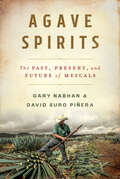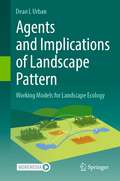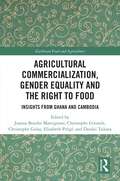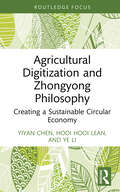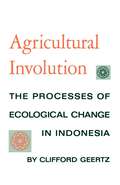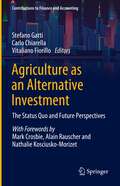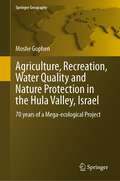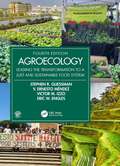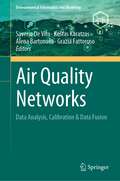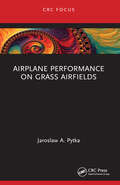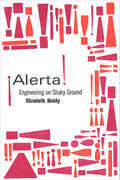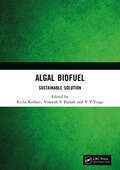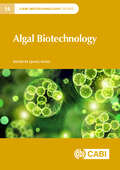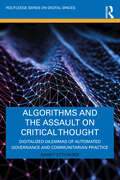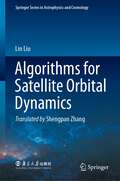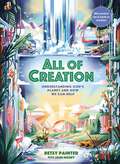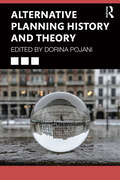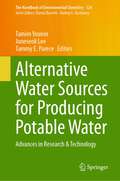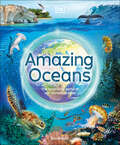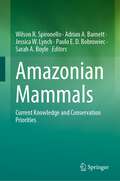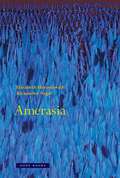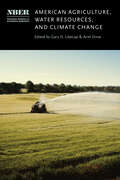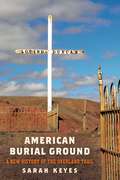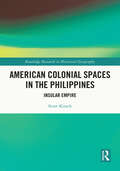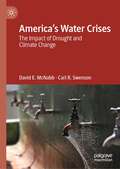- Table View
- List View
Agave Spirits: The Past, Present, And Future Of Mezcals
by Gary Paul Nabhan David Suro Piñera“A manifesto…[and] a positive spin on the future of mezcal.” —Florence Fabricant, New York Times The agave plant was never destined to become tasteless, cheap tequila. All tequilas are mezcals; all mezcals are made from agaves; and every bottle of mezcal is the remarkable result of collaborations among agave entrepreneurs, botanists, distillers, beverage distributors, bartenders, and more. How these groups come together in this “spirits world” is the subject of this fascinating new book by the acclaimed ethnobotanist Gary Paul Nabhan and the pioneering restauranteur David Suro Piñera. Join them as they delight in the diversity of the distillate agave spirits, as they endeavor to track down the more distant kin in the family of agaves, and as, along the way, they reveal the stunning innovations that have been transforming the industry around tequilas and mezcals in recent decades. The result of the authors’ fieldwork and on-the-ground interviews with mezcaleros in eight Mexican states, Agave Spirits shows how traditional methods of mezcal production are inspiring a new generation of individuals, including women, both in and beyond the industry. And as they reach back into a rich, centuries-long history, Nabhan and Suro Piñera make clear that understanding the story behind a bottle of mezcal, more than any other drink, will not only reveal what lies ahead for the tradition—including its ability to adapt in the face of the climate crisis—but will also enrich the drinking experience for readers. Essential reading for mezcal connoisseurs and amateurs interested in unlocking the past of a delightful distillate, Agave Spirits tells the tale of the most flavorful and memorable spirits humankind has ever sipped and savored. Featuring twelve illustrations by René Alejandro Hernández Tapia and indices that list common and scientific names for agave species, as well as the names of plants, animals, and domesticated agaves used in the production of distillates.
Agents and Implications of Landscape Pattern: Working Models for Landscape Ecology
by Dean L UrbanThis is an ecology textbook focused on key principles that underpin research and management at the landscape scale. It covers (1) agents of pattern (the physical template, biotic processes, and disturbance regimes); (2) scale and pattern (why scale matters, how to ‘scale’ with data, and inferences using landscape pattern metrics); and (3) implications of pattern (for metapopulations, communities and biodiversity, and ecosystem processes). The last two chapters address emerging issues: urban landscapes, and adapting to climate change. This book stems from two graduate-level courses in Landscape Ecology taught at the Nicholas School of the Environment at Duke University. The subject has evolved over time, from a concepts-based overview of what landscape ecology is, to a more applied practicum on how one does landscape ecology. As landscape ecology has matured as a discipline, its perspectives on spatial heterogeneity and scale have begun to permeate into a wide range of other fields including conservation biology, ecosystem management, and ecological restoration. Thus, this textbook will bring students from diverse backgrounds to a common level of understanding and will prepare them with the practical knowledge for a career in conservation and ecosystem management.
Agricultural Commercialization, Gender Equality and the Right to Food: Insights from Ghana and Cambodia (Earthscan Food and Agriculture)
by Joanna Bourke Martignoni Christophe Gironde Christophe Golay Elisabeth Prügl Dzodzi TsikataThis volume explores agricultural commercialization from a gender equality and right to food perspective. Agricultural commercialization, involving not only the shift to selling crops and buying inputs but also the commodification of land and labour, has always been controversial. Strategies for commercialization have often reinforced and exacerbated inequalities, been blind to gender differences and given rise to violations of the human rights to food, land, work and social security. While there is a body of evidence to trace these developments globally, impacts vary considerably in local contexts. This book systematically considers these dynamics in two countries, Cambodia and Ghana. Profoundly different in terms of their history and location, they provide the basis for fruitful comparisons because they both transitioned to democracy in the early 1990s, made agricultural development a priority, and adopted orthodox policies of commercialization to develop the sector. Chapters illustrate how commercialization processes are gendered, highlighting distinctive gender, ethnic and class dynamics in rural Ghana and Cambodia and the different outcomes these generate. They also show the ways in which food cultures are changing and the often-problematic impact of these changes on the safety and quality of food. Specific policies and legal norms are examined, with chapters addressing the development and implementation of frameworks on the right to food and land administration. Overall, the volume brings into relief multiple dimensions shaping the outcomes of processes of commercialization, including gender orders, food cultures, policy translation, national and sub-national policies, corporate investments and programmes, and formal and informal legal norms. In doing so, it offers insight not only on our case countries, but also provides proposals to advance rights-based research on food security. This book will be of great interest to students and scholars of food security, agricultural development and economics, gender, human rights and sustainable development.
Agricultural Digitization and Zhongyong Philosophy: Creating a Sustainable Circular Economy (Routledge Focus on Environment and Sustainability)
by Yiyan Chen Hooi Hooi Lean Ye LiThis interdisciplinary book combines digital technology with Eastern philosophy to examine how the concept of Zhongyong in Confucianism can be used to coordinate digital technology with sustainable agriculture. Zhongyong comes from the connotation of moderate and sustainable in ancient Chinese culture. It is with this concept in mind that this book presents a novel collaboration between philosophy and computer technology to explain how Zhongyong can play an important part in realizing agricultural digitization within a circular economy in order to help solve the current food crisis. The book examines two popular, yet contradictory, digital technologies—blockchain and the green data center. It showcases how the use of traditional Chinese Zhongyong can promote the decentralization of blockchain and the centralization of the green data center and explains the advantages of using both technologies simultaneously. The book puts forward a digital circular agricultural framework that embeds both blockchain and the green data center through an actual case study. While this book specifically focuses on agriculture, it also provides readers with a new perspective for thinking further on how to break down the disciplinary barriers between the social sciences and natural sciences. This book will be of great interest to students and scholars of agriculture, digital technologies, circular economy, sustainable development, and Eastern philosophy.
Agricultural Involution: The Processes of Ecological Change in Indonesia
by Clifford GeertzAgricultural Involution: The Processes of Ecological Change in Indonesia is one of the most famous of the early works of Clifford Geertz. It principal thesis is that many centuries of intensifying wet-rice cultivation in Indonesia had produced greater social complexity without significant technological or political change, a process Geertz terms "involution".Written for a US-funded project on the local developments and following the modernization theory of Walt Whitman Rostow, Geertz examines in this book the agricultural system in Indonesia and its two dominant forms of agriculture, swidden and sawah. In addition to researching its agricultural systems, the book turns to an examination of their historical development. Of particular note is Geertz's discussion of what he famously describes as the process of "agricultural involution" in Java, where both the external economic demands of the Dutch rulers and the internal pressures due to population growth led to intensification rather than change.
Agriculture as an Alternative Investment: The Status Quo and Future Perspectives (Contributions to Finance and Accounting)
by Stefano Gatti Carlo Chiarella Vitaliano FiorilloUnder the pressure of climate and social changes, agriculture is called to play a fundamental role in the world food challenge of the next few decades. A severe reduction of arable land and water scarcity combined with a growing food demand, changes in the dietary preferences in many countries and, more recently, a growing threat to food security and logistics from supply chains interruptions and global trade fragmentation, all require the implementation of processes, techniques, and innovations able to increase productivity and make a better use of scarce resources.Against this backdrop, a growing number of investors and asset managers have started looking at agriculture as an interesting investment theme to exploit the long-term strategic opportunities emerging from technological innovation and social changes. The industry is undergoing a process of transformation driven, on the one hand, by the emergence of new data and technologies that promise enhancing process efficiency and improve yields and, on the other hand, by an increased attention on the GHG emissions of agricultural processes and the impact of farmland on climate change, water and land scarcity. All these factors call for a radical rethinking of many agriculture business models. This book provides a detailed overview and analysis of those new technologies with the greatest potential to disrupt agriculture products and processes by improving productivity and the management of food loss and waste, making a more efficient and sustainable use of resources and enhancing food security. Then, it discusses the implications for investors and asset managers, starting with an assessment of the status quo of agriculture investing and providing a thorough description of the agriculture asset class with an emphasis on its distinctive characteristics and the innovations in the technological processes used in agriculture and farming with the greatest potential to obtain long-term sustainable returns.
Agriculture, Recreation, Water Quality and Nature Protection in the Hula Valley, Israel: 70 years of a Mega-ecological Project (Springer Geography)
by Moshe GophenThe anxious search for agricultural income resources, and assurance of the national water supply in the northern newly created state of Israel initiated the national project of the Hula Drainage. The implementation of this project was accompanied as of today by research and monitoring of the ecological trait aimed at crop harvest improvement in the Hula valley and prevention of water quality deterioration in Lake Kinneret. Forty years later a reclamation project to improve the peat soil property and renovate the hydrological system was carried out. This book documents the scientific research carried out during this mega-ecological project. Several issues of the ecological renovation and its impact on the Hula valley management and water quality in lake Kinneret are presented in this book. The advantage and contribution of a newly created shallow lake Agmon-Hula to nutrient dynamics, and hydrological control, accompanied by avian presence, (among others, Cranes, Storks, Pelicans, Flamingoes) and plants renewal which enhanced, tourism; potential impact of nitrogen and sulfate migration from the Hula valley on the Kinneret water quality; the role of climate change on the ecology of the Hula Valley and the Kinneret nutrient availabilities and phytoplankton community; the subterranean migration of water and nutrients and water loss. Further proposals for future development are under consideration. This book presents a comprehensive practical management implementation of a long-term ecological project. Results of scientific and monitoring research which followed the project implementation benefit the international and national communities.
Agroecology: Leading the Transformation to a Just and Sustainable Food System (Advances in Agroecology)
by Stephen R. Gliessman V. Ernesto Méndez Victor M. Izzo Eric W. EnglesAgroecology is at the forefront of transforming our food systems. This bestselling textbook provides the essential foundation for understanding this transformation in all its components: agricultural, ecological, economic, social, cultural, and political. It presents a case for food system change, explains the principles and practices underlying the ecological approach to food production, and lays out a vision for a food system based on equity and greater compatibility with the planet’s life support systems. New to the fourth edition: A chapter on Alternatives to Industrial Agriculture, covering the similarities and distinctions among different approaches to sustainable agriculture A chapter on Ecological Pest, Weed, and Disease Management A chapter on Urban and Peri-urban Agriculture A chapter on Agriculture and the Climate Crisis A revised analysis and critique of the food system’s embeddedness in the extractive capitalist world economy that reflects ideas in the emerging field of political agroecology. Streamlined treatment of agroecology’s foundations in ecological science, making the text more compatible with typical course curricula. A Companion Website incorporates the entire contents of the updated practical manual Field and Laboratory Investigations in Agroecology, split into student and lecturer resources. These 24 sample investigations facilitate hands-on learning that involves close observation, creative interpretation, and constant questioning of findings. Groundbreaking in its first edition and established as the definitive text in its second and third, the fourth edition of Agroecology captures recent developments in the field and forcefully applies the idea that agroecology is a science, a movement, and a practice. Written by a team of experts, this book will encourage students and practitioners to consider the critical importance of transitioning to a new paradigm for food and agriculture.
Air Quality Networks: Data Analysis, Calibration & Data Fusion (Environmental Informatics and Modeling)
by Saverio De Vito Kostas Karatzas Alena Bartonova Grazia FattorusoThis volume offers expert contributions proposing new and recently set scientific standards for smart air quality (AQ) networks data processing, along with results obtained during field deployments of pervasive and mobile systems. The book is divided into 5 main sections; 1) future air quality networks, 2) general data processing techniques, 3) field deployments performances, 4) special applications, and 5) cooperative and regulatory efforts. The authors offer different sources of data for the production of trustworthy insights, including spatio-temporal predictive AQ maps meant to boost citizen awareness, and informed participation in remediation and prevention policies. Readers will learn about the best and most up-to-date practices for measuring and assessing air quality, while also learning about current regulatory statuses regarding air quality technology design and implementation. The book will be of interest to air quality regulatory agencies, citizen science groups, city authorities, and researchers and students working with air quality sensors and geostatistics.
Airplane Performance on Grass Airfields
by Jaroslaw A. PytkaAirplane Performance on Grass Airfields presents an experiment-based approach to analysis and flight testing of airfield performance on grass runways. It discusses improvements for operations efficiency and safety of these airfields. The book analyzes the interaction between the landing gear wheels and the surface of a grass runways during both takeoff and landing. Considering the ground performance of an aircraft on a grass runway, the book covers test methods and devices for measuring performance and introduces an information system for the surface condition of grass airfields: GARFIELD. The system is based on a tire-grass interaction model and uses digital soil maps, as well as current meteorological data obtained from a weather server. The book is intended for researchers and practicing engineers in the fields of aviation and aircraft safety and performance.
¡Alerta!: Engineering on Shaky Ground
by Elizabeth ReddyA lively account of a controversial technology developed to mitigate earthquake risk and change how we live with threatening environments.The Sistema de Alerta Sísmica Mexicano is the world&’s oldest public earthquake early warning system. Given the unpredictability of earthquakes, the technology was designed to give the people of Mexico City more than a minute to prepare before the next big quake hits. How does this kind of environmental monitoring technology get built in the first place? How does its life-saving promise align with reality? And who shapes modern risk mitigation? In ¡Alerta!, Elizabeth Reddy surveys this innovation to shed light on what it means to imagine a world where sirens could sound out an ¡alerta sísmica! at any moment—and what it would be like to live in such a world.Proponents of earthquake early warnings have long held that the technology can save lives and limit economic losses. Drawing on ethnographic fieldwork and archival data, Reddy conducts a thorough, qualitative analysis of these claims and considers the requirements and uses of the alert system. She embeds her study in a rich narrative of the engineers who designed the system in conjunction with contingent political and environmental conditions. The result demonstrates how addressing earthquake dangers is no small task: it means trying to change relationships between the environment, society, and technology. Doing so, she critiques universalist and techno-centric approaches to hazard risk mitigation and celebrates the potential of contextually appropriate and broadly supported efforts.¡Alerta! takes readers on a vivid journey into the world of Mexican earthquake risk mitigation, with critical insights for anthropologists and science and technology studies scholars, as well as specialists in the geosciences, engineering, and emergency management.
Algal Biofuel: Sustainable Solution
by Richa Kothari Vinayak V. Pathak V. V. TyagiAlgal Biofuel: Sustainable Solution primarily focuses on the different aspects of bioenergy production using algal biomass as microalgae are considered the optimum feedstock for bioenergy production. The major aim is to thoroughly review the available bioenergy options, challenges in bioenergy production, availability of bioenergy feedstock, and biomass to bioenergy conversion process. This book also highlights the feasibility of lignocellulosic biomass, crop residues, and non-edible oil seeds for generation of different bioenergy products. It will be helpful for researchers and other stakeholders working in the area of bioenergy production for development of innovative concepts in emerging areas of bioenergy. Print edition not for sale in South Asia (India, Sri Lanka, Nepal, Bangladesh, Pakistan and Bhutan).
Algal Biotechnology (CABI Biotechnology Series)
by Yahui Bo Gao Chen Lei Chen Zhenfan Chen Zixi Chen Pengfei Cheng Feng Ge Jiameng Guo Sanjay Gupta Xiahui Hao Qingfang He Fan Hu Hanhua Hu Krishna Kumar Jaiswal Hu Jin Vinod Kumar Anping Lei Anna I. Kurbatova Chao Li Yanhua Li Hanzhi Lin Lu-Ning Liu Qiong Liu Yandu Lu Anastasios Melis Yufang Pan Vishal Rajput Roger Ruan Shengzhou Shan Kaitlin Simmons Xiaotong Song Xinyu Song Adamu Yunusa Ugya Mikhail S. Vlaskin Chun Wang Jiangxin Wang Jin Wang Xiaojun Yan Wenxiu Yin Weiwen Zhang Xiangxiang Zhang Xu Zhang Yu-Zhong Zhang Long-Sheng Zhao Quanyu Zhao Chengxu Zhou Yali Zhu Zhu Zhen Tian Jing Cao XupengAlgae are sunlight-driven cell factories, and can efficiently absorb CO2 and convert light energy to chemical energy such as lipid, starch and other carbohydrates and release O2. Algal feedstock is a promising resource for bioproduct production, given its high photosynthetic efficiency for producing biomass compared to conventional crops. Microalgae can be used for flue-gas and wastewater bioremediation. This book highlights recent breakthroughs in the multidisciplinary areas of algal biotechnology and the chapters feature recent developments from cyanobacteria to eukaryotic algae, from theoretical biology to applied biology. It also includes the latest advancements in algal-based synthetic biology, including metabolic engineering, artificial biological system construction and green chemicals production. With contributions by leading authorities in algal biotechnology research, it is a valuable resource for graduate students and researchers in the field, and those involved in the study of photosynthesis and green-cell factories.
Algorithms and the Assault on Critical Thought: Digitalized Dilemmas of Automated Governance and Communitarian Practice (Routledge Series on Digital Spaces)
by Nancy EttlingerThis book examines the digitalization of longstanding problems of technological advance that produce inequalities and automated governance, which relieves subjects of agency and critical thought, and prompts a need to weaponize thoughtfulness against technocratic designs. The book situates digital-era problems relative to those of previous sociotechnical milieux and argues that technical advance perennially embeds corrosive effects on social relations and relations of production, recognizing variation across contexts and relative to entrenched societal hierarchies of race and other axes of difference and their intersections. Societal tolerance, despite abundant evidence for harmful effects of digital technologies, requires attention. The book explains blindness to social injustice by technocratic thinking delivered through education as well as truths embraced in the data sciences coupled with governance in universities and the private sector that protect these truths from critique. Institutional inertia suggests benefits of communitarianism, which strives for change emanating from civil society. Scaling postcapitalist communitarian values through communitybased peer production presents opportunities. However, enduring problems require critical reflection, continual revision of strategies, and active participation among diverse community citizens. This book is written with critical geographic sensibilities for an interdisciplinary audience of scholars and graduate and undergraduate students in the social sciences, humanities, and data sciences.
Algorithms for Satellite Orbital Dynamics (Springer Series in Astrophysics and Cosmology)
by Lin LiuThis book highlights the fundamental physics of orbit theory, dynamical models, methods of orbit determination, design, measurement, adjustment, and complete calculations for the position, tracking, and prediction of satellites and deep spacecraft. It emphasizes specific methods, related mathematical calculations, and worked examples and exercises. Therefore, technicians and engineers in the aerospace industry can directly apply them to their practical work. Dedicated to undergraduate students and graduate students, researchers, and professionals in astronomy, physics, space science, and related aerospace industries, the book is an integrated work based on the accumulated knowledge in satellite orbit dynamics and the author’s more than five decades of personal research and teaching experience in astronomy and aerospace dynamics.
All of Creation: Understanding God’s Planet and How We Can Help
by Betsy PainterFrom conservation to protecting endangered species to sustainable living, All of Creation offers young readers accessible and fascinating information on the challenges our planet faces and practical ways we can care for the magnificent world around us.Drawing on science and Scripture, this hope-filled and kid-friendly guide to planet Earth addresses our most pressing questions about caring for and respecting God's world, such as:What are the biggest challenges our planet faces, and what impact do they have on our lives?What guidance does the Bible offer to help us navigate environmental issues such as pollution, food shortages, and deforestation?What simple choices can we make to help restore and protect God's creation? Gorgeously detailed illustrations throughout highlight the beauty of the natural world, while practical tips and activities at the end of each chapter show how we can become better stewards of the Earth and support efforts that make a positive difference in the world.All of Creation is ideal for:Readers ages 8-12 who are interested in conservation and the environmentYoung people who want to get involved but don&’t know where to startGift-giving occasions such as birthdays, Christmas, Easter, and other holidays
Alternative Planning History and Theory
by Dorina PojaniThis book includes twelve carefully commissioned chapters each of which presents an alternative planning history and theory written from the perspective of groups that have been historically marginalized or neglected. In teaching planning history and theory, many planning programs tend to follow the planning cannon - a normative perspective that mostly accounts for the experience of white, Anglo, Christian, middle class, middle aged, heterosexual, able-bodied, men. This book takes a unique approach. It provides alternative planning history and theory timelines for each of the following groups: women, the poor, LGBTQ+ communities, people with disabilities, older adults, children, religious minorities, people of color, migrants, Indigenous people, and colonized peoples (in South Asia and Sub-Saharan Anglophone Africa). To allow for easy cross-comparison, chapters follow a similar chronological structure, which extends from the late 19th century into the present. The authors provide insights into the core planning issues in each time period, and review the different stances and critiques. The book is a must-read for planning students and instructors. Each chapter includes the following pedagogical features: (1) a boxed case study which presents a recent example of positive change to showcase theory in practice; (2) a table which lays out an alternative planning history and theory timeline for the group covered in the chapter; and (3) suggestions for further study comprising non-academic sources such as books, websites, and films.
Alternative Water Sources for Producing Potable Water: Advances in Research & Technology (The Handbook of Environmental Chemistry #124)
by Tamim Younos Juneseok Lee Tammy E. PareceDuring the third decade of the 21st century, communities across the world are being challenged with water scarcity both in rural and urban areas. Another significant problem is the energy demand for producing potable water. Our recent book “Resilient Water Management Strategies in Urban Settings: Innovations in Decentralized Water Infrastructure Systems” (Springer; 2022) introduced various facets of decentralized water infrastructure and the significant need for a shift toward using locally available alternative water sources. The proposed volume will expand on the concept and use of alternative water sources; rainwater, stormwater, wastewater/greywater, saline waters, and atmospheric water. Use of alternative water sources for potable purposes is a critical emerging research and technology area. In our knowledge such a book does not exist at this time. This volume will be a significant resource for researchers and graduate level teaching, and serve as a roadmap for water resource engineers and planners tackling water scarcity and diverse water resources portfolios.
Amazing Oceans: The Surprising World of Our Incredible Seas (DK Amazing Earth)
by Annie RothGo on an underwater adventure in this detailed look at our oceans&’ most fascinating places, plants and animals.This fascinating book will take children beyond the seaweed, sharks, and shells that you have seen many times before, and show you the secret world that lies in and around our amazing oceans. This ocean book for children aged 7-9 delves into facts about our marine environments that most people don&’t know. Dive into the deepest sea trench ever discovered, marvel at immortal anemones, and learn how devastating water tornadoes form. Kids can ponder at a whole range of topics, from unique ocean habitats, newly-discovered creatures, marine mysteries, and the exciting world of ocean exploration.This educational ocean book for kids offers: Enticing information on the most incredible ocean features, explaining how they work, why they are unusual, and what is amazing about them.Detailed diagrams, maps and charts that bring the beauty, science or geography of each topic to life.Spectacular photography, including incredible satellite images and mind-boggling microscope photos, to maximize the impact of each topic.Have you ever wondered how big the oceans actually are? Or how animals communicate in the water? Or how plants are able to grow in the sea? This book answers those questions, and many, many more. Amazing Oceans is the ideal book for inquisitive kids aged 7 and above, and especially those with a passion for wildlife, science, or geography. With in-depth information, vivid photographs and illustrations, children can get to know the most incredible environments on Earth.
Amazonian Mammals: Current Knowledge and Conservation Priorities
by Wilson R. Spironello Adrian A. Barnett Jessica W. Lynch Paulo E. D. Bobrowiec Sarah A. BoyleThe mammal fauna of the Brazilian Amazon is one of the most diverse on Earth with over 450 known species. Bringing together more than 70 of the world’s top experts on Amazonian mammals, this book unites, for the first time, up-to-date data on the current state of knowledge on the ecology of all groups of non-rodent mammals in the Brazilian Amazon, analyses the effectiveness of current conservation programmes and identifies research and conservation priorities for the future.
Amerasia
by Elizabeth Horodowich Alexander NagelA connected world as imagined by early modern European artists, mapmakers, and writers, where Asia and the Americas were on a continuumAmerica and Asia mingled in the geographical and cultural imagination of Europe for well over a century after 1492. Through an array of texts, maps, objects, and images produced between 1492 and 1700, this compelling and revelatory study immerses the reader in a vision of a world where Mexico really was India, North America was an extension of China, and South America was marked by a variety of biblical and Asian sites. It asks, further: What does it mean that the Amerasian worldview predominated at a time when Europe itself was coming into cultural self-definition? Each of the chapters focuses on a particular artifact, map, image, or book that illuminates aspects of Amerasia from specific European cultural milieus. Amerasia shows how it was possible to inhabit a world where America and Asia were connected either imaginatively when viewed from afar, or in reality when traveling through the newly encountered lands. Readers will learn why early modern maps regularly label Mexico as India, why the “Amazonas” region was named after a race of Asian female warriors, and why artifacts and manuscripts that we now identify as Indian and Chinese are entangled in European collections with what we now label Americana.Elizabeth Horodowich and Alexander Nagel pose a dynamic model of the world and of Europe’s place in it that was eclipsed by the rise of Eurocentric colonialist narratives in the nineteenth and twentieth centuries. To rediscover this history is an essential part of coming to terms with the emergent polyfocal global reality of our own time.
American Agriculture, Water Resources, and Climate Change (National Bureau of Economic Research Conference Report)
by Gary D. Libecap and and Ariel DinarA collection of the most advanced and authoritative agricultural-economic research in the face of increasing water scarcity. Agriculture has been critical in the development of the American economy. Except in parts of the western United States, water access has not been a critical constraint on agricultural productivity, but with climate change, this may no longer be the case. This volume highlights new research on the interconnections between American agriculture, water resources, and climate change. It examines climatic and geologic factors that affect the agricultural sector and highlights historical and contemporary farmer responses to varying conditions and water availability. It identifies the potential effects of climate change on water supplies, access, agricultural practices, and profitability, and analyzes technological, agronomic, management, and institutional adjustments. Adaptations such as new crops, production practices, irrigation technologies, water conveyance infrastructure, fertilizer application, and increased use of groundwater can generate both social benefits and social costs, which may be internalized with various institutional innovations. Drawing on both historical and present experiences, this volume provides valuable insights into the economics of water supply in American agriculture as climate change unfolds.
American Burial Ground: A New History of the Overland Trail (America in the Nineteenth Century)
by Sarah KeyesIn popular mythology, the Overland Trail is typically a triumphant tale, with plucky easterners crossing the Plains in caravans of covered wagons. But not everyone reached Oregon and California. Some 6,600 migrants perished along the way and were buried where they fell, often on Indigenous land. As historian Sarah Keyes illuminates, their graves ultimately became the seeds of U.S. expansion.By the 1850s, cholera epidemics, ordinary diseases, and violence had remade the Trail into an American burial ground that imbued migrant deaths with symbolic power. In subsequent decades, U.S. officials and citizens leveraged Trail graves to claim Native ground. Meanwhile, Indigenous peoples pointed to their own sacred burial grounds to dispute these same claims and maintain their land. These efforts built on anti-removal campaigns of the 1820s and 30s, which had established the link between death and territorial claims on which the significance of the Overland Trail came to rest.In placing death at the center of the history of the Overland Trail, American Burial Ground offers a sweeping and long overdue reinterpretation of this historic touchstone. In this telling, westward migration was a harrowing journey weighed down by the demands of caring for the sick and dying. From a tale of triumph comes one of struggle, defined as much by Indigenous peoples’ actions as it was by white expansion. And, finally, from a migration to the Pacific emerges instead a trail of graves. Graves that ultimately undergirded Native dispossession.
American Colonial Spaces in the Philippines: Insular Empire (Routledge Research in Historical Geography)
by Scott KirschAmerican Colonial Spaces in the Philippines tells the story of U.S. colonialists who attempted, in the first decades of the twentieth century, to build an enduring American empire in the Philippines through the production of space. From concrete interventions in infrastructure, urban planning, and built environments to more abstract projects of mapping and territorialization, the book traces the efforts of U.S. Insular Government agents to make space for empire in the Philippines through forms of territory, map, landscape, and road, and how these spaces were understood as solutions to problems of colonial rule. Through the lens of space, the book offers an original history of a highly transformative, but largely misunderstood or forgotten, imperial moment, when the Philippine archipelago, made up of thousands of islands and an ethnically and religiously diverse population of more than seven million, became the unlikely primary setting for U.S. experimentation with formal colonial governance. Telling that story around key figures including Cameron Forbes, Daniel Burnham, Dean Worcester, and William Howard Taft, the book provides distinctive chapters dedicated to spaces of territory (sovereignty), maps (knowledge), landscape (aesthetics), and roads (circulation), suggesting new and integrative historical geographical approaches. This book will be of interest to students of Cultural, Historical, and Political Geography, American History, American Studies, Philippine Studies, Southeast Asia/Philippines; Asian Studies as well as general readers interested in these areas.
America’s Water Crises: The Impact of Drought and Climate Change
by David E. McNabb Carl R. SwensonThis book is focused exclusively on water problems in the 48 U.S. states. The authors provide an accessible overview of the work of many federal, state and academic researchers and water system administrators whose investigations have focused on the state of water and the water crisis now accelerating in the United States. David McNabb and Carl Swenson seek to bring to a wider audience some of the current research findings and data on the perilous state of the United States’ surface and groundwater resources during this time of climate change and the extreme drought taking place in many sections of the nation. Descriptions of the water resource systems are based on research and the subsequent findings published by water scientists in the United States Geological Survey, the Environmental Protection Agency, the U.S. Corps of Engineers and water related agencies of the Departments of Agriculture and of the Interior and state and local water management agencies.
